Different Types of Animals
Key Difference: Animal kingdom consists of many different types of animals, but still all the animal share common characteristics. They all are multicellular means made up of more than one cell. They do not contain any cell walls like plant cells, and they usually consume or eat other organisms too.
Kingdom of animals is very diverse and therefore, it becomes little difficult to place them in different categories. However, the classification is achieved by using scientific taxonomy. Animals are placed in different phyla (divisions) based on their characteristics.
Animals are generally classified according to these Phyla –
Anthropod Phylum – It consists of all the jointed legged invertebrate animals. These animals also bear an exoskeleton, which refers to the skeleton present on the outside of the body. Nearly 85 percent of the well-known animals belong to this group. These phylum consists of classes :
.jpg) Arachnid Class: it consists of animals like spiders, mites, ticks, scorpions, etc. They are generally terrestrial and predacious. They usually have sucking mouthparts. It includes nearly 93,000 species of animals. They possess four pairs of walking legs. They do not have any wings or antennae, and this is what makes it apart from insects.
Arachnid Class: it consists of animals like spiders, mites, ticks, scorpions, etc. They are generally terrestrial and predacious. They usually have sucking mouthparts. It includes nearly 93,000 species of animals. They possess four pairs of walking legs. They do not have any wings or antennae, and this is what makes it apart from insects.
 Malacostracan Class: Lobsters, crabs and shrimp fall in this group. It consists of diverse types of marine, freshwater and terrestrial crustaceans. These animals are recognized by a maximum of 19 pairs of appendages.Stomatopods, euphausiids, etc. all belong to this class. Body of Malacostracans is divided into three tagmata – cephalon, thorax and abdomen. Head and thorax are combined and therefore it is difficult to differentiate them. It consists of nearly 25,000 species.
Malacostracan Class: Lobsters, crabs and shrimp fall in this group. It consists of diverse types of marine, freshwater and terrestrial crustaceans. These animals are recognized by a maximum of 19 pairs of appendages.Stomatopods, euphausiids, etc. all belong to this class. Body of Malacostracans is divided into three tagmata – cephalon, thorax and abdomen. Head and thorax are combined and therefore it is difficult to differentiate them. It consists of nearly 25,000 species.
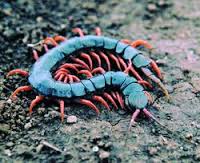 Chilopodan Class: This class mainly comprises of centipedes. They possess one pair of antennae and well developed mouthparts. Their body is segmented and each of these segments contains one pair of legs. The legs in the first body segment are converted into poisonous jaws. They are insectivorous and eat other arthropods also.
Chilopodan Class: This class mainly comprises of centipedes. They possess one pair of antennae and well developed mouthparts. Their body is segmented and each of these segments contains one pair of legs. The legs in the first body segment are converted into poisonous jaws. They are insectivorous and eat other arthropods also.
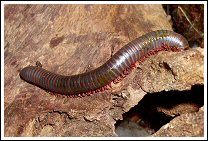 Diplopodan Class: This class mainly consists of millipedes. Like centipedes, these are also many legged arthropods. They primarily feed on decomposed plant material. The body is divided into two tagmata. They are generally many centimeters long. They are commonly found under stones and debris, and also in leaf litter.
Diplopodan Class: This class mainly consists of millipedes. Like centipedes, these are also many legged arthropods. They primarily feed on decomposed plant material. The body is divided into two tagmata. They are generally many centimeters long. They are commonly found under stones and debris, and also in leaf litter.
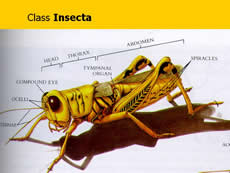 Insecta Class: This class consists of many different types of animal. It includes various orders like Coleopteran Order, Dipteran Order, Lepidopteran Order, Hymenopteran Order, Hemipteran Order, Dictyopteran Order and Orthropteran Order. Simply, it includes flies, ants, bees, cockroaches, beetles, grasshoppers, etc. An adult member of this class contains three pairs of leg, a segmented body which includes a head, thorax, abdomen and one pair of antennae. They usually have compound eyes. They are the only invertebrates with the ability of flight, and therefore many of these insects also bear wings on them.
Insecta Class: This class consists of many different types of animal. It includes various orders like Coleopteran Order, Dipteran Order, Lepidopteran Order, Hymenopteran Order, Hemipteran Order, Dictyopteran Order and Orthropteran Order. Simply, it includes flies, ants, bees, cockroaches, beetles, grasshoppers, etc. An adult member of this class contains three pairs of leg, a segmented body which includes a head, thorax, abdomen and one pair of antennae. They usually have compound eyes. They are the only invertebrates with the ability of flight, and therefore many of these insects also bear wings on them.
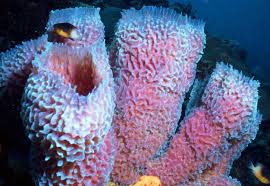 Poriferan Phylum – This phylum mainly consists of sponges which are mainly marine animals. They are considered to be very simple type of animals. These are deprived of true tissues. They are mainly radically symmetrical. They do not possess digestive tract and also lack the gastrula stage. There are nearly 5000 to 10000 known species of sponges which primarily eat floating organic particles and plankton.
Poriferan Phylum – This phylum mainly consists of sponges which are mainly marine animals. They are considered to be very simple type of animals. These are deprived of true tissues. They are mainly radically symmetrical. They do not possess digestive tract and also lack the gastrula stage. There are nearly 5000 to 10000 known species of sponges which primarily eat floating organic particles and plankton.
.jpg) Cnidearian Phylum – It includes animals like jellyfish, sea anemones, etc. which are mostly aquatic or live in marine type of environment. It contains nearly 9000 species. They are mostly found in marine habitats in comparison to fresh water. They all possess a specialized type of stinging cell organelle. The body can be either in the polyp or medusa form.
Cnidearian Phylum – It includes animals like jellyfish, sea anemones, etc. which are mostly aquatic or live in marine type of environment. It contains nearly 9000 species. They are mostly found in marine habitats in comparison to fresh water. They all possess a specialized type of stinging cell organelle. The body can be either in the polyp or medusa form.
.jpg) Mullusc Phylum – It consists of Classes Gastropod, Cephalpod and Bivalvian. It means it includes snails, slugs, squids, octopi, clams, oysters, etc. The word Mollusks means soft of the body. They are bilaterally symmetrical and body consists of more than two cell layers. They possess a body without cavity. Their body can be divided into three parts mainly – head, visceral hump and foot.
Mullusc Phylum – It consists of Classes Gastropod, Cephalpod and Bivalvian. It means it includes snails, slugs, squids, octopi, clams, oysters, etc. The word Mollusks means soft of the body. They are bilaterally symmetrical and body consists of more than two cell layers. They possess a body without cavity. Their body can be divided into three parts mainly – head, visceral hump and foot.
 Annelid Phylum – Segmented worms fall in this group. They are bilaterally symmetrical and vermiform. Their body can be divided into three parts – a prosomium, a trunk and a pygidium. They feed on various types of materials. They also possess a true closed circulatory system. They generally prefer to live in aquatic environment, however there are many terrestrial species also included in this group.
Annelid Phylum – Segmented worms fall in this group. They are bilaterally symmetrical and vermiform. Their body can be divided into three parts – a prosomium, a trunk and a pygidium. They feed on various types of materials. They also possess a true closed circulatory system. They generally prefer to live in aquatic environment, however there are many terrestrial species also included in this group.
Chordate Phylum – This phylum includes all animals that bear a hollow nerve cord and a notochord, which is a flexible rod which exits between the nerve cord and the digestive text. It contains nearly more than 43000 species. Most of these species belong to the subphylum Vertebrata. It includes important classes like -

Reptile Class – It includes animals like turtles, crocodile, lizards, snakes, etc. These animals are fully terrestrial. They have no larval stages and no metamorphosis.
The word has been taken from Italian word meaning creeping. It consists of cold blooded animals. These reptiles have well developed lungs right from the beginning of their birth. Except crocodiles, all of the reptiles contains four chambered hearts.
 Amphibian Class – The word Amphibian refers to double life or both sided life (survive on water as well as land). Frogs, toads and salamanders are examples of amphibian. They do not have well developed lungs and possess toes but without claws. Their heart is three chambered. They are cold blooded animals. They hibernate for a very long time which can even last for several months. They usually feed on exuviated skin.
Amphibian Class – The word Amphibian refers to double life or both sided life (survive on water as well as land). Frogs, toads and salamanders are examples of amphibian. They do not have well developed lungs and possess toes but without claws. Their heart is three chambered. They are cold blooded animals. They hibernate for a very long time which can even last for several months. They usually feed on exuviated skin.
 Avain Class – It is also known as Aves class. It includes all birds. Birds are warm blooded animals with hollow bones and feathers. They are born from hard shelled eggs. It includes gulls, songbirds, fowl, etc. Their feathers and ability to fly is what makes them different from other types of chordates. They have feathers like down feathers, filoplumes, contour feathers or quill feathers.
Avain Class – It is also known as Aves class. It includes all birds. Birds are warm blooded animals with hollow bones and feathers. They are born from hard shelled eggs. It includes gulls, songbirds, fowl, etc. Their feathers and ability to fly is what makes them different from other types of chordates. They have feathers like down feathers, filoplumes, contour feathers or quill feathers.
 Chondrichthye Class – It consists of nearly 600 species of rays, sharks, and ratfish. The main characteristics of Chondrichthyes are that they have no lungs and swim bladder. Their skin is covered by placoid scales and mucous glands. They possess true jaws and true teeth. They are oviparous or viviparous.
Chondrichthye Class – It consists of nearly 600 species of rays, sharks, and ratfish. The main characteristics of Chondrichthyes are that they have no lungs and swim bladder. Their skin is covered by placoid scales and mucous glands. They possess true jaws and true teeth. They are oviparous or viviparous.
 Actinopterygii Class – This class consists of ray finned fishes. They possess fins which are actually webs of skin and are assisted by bony or horny spines. They are found in marine and freshwater. Tradionally, they are classified into two subclasses namely - Chondrostei and Neopterygii.
Actinopterygii Class – This class consists of ray finned fishes. They possess fins which are actually webs of skin and are assisted by bony or horny spines. They are found in marine and freshwater. Tradionally, they are classified into two subclasses namely - Chondrostei and Neopterygii.
 Mammalian Class – It consists of warm blooded animals. They possess four chambered heart. Hair of the mammals are composed of keratin. They possess teeth which are imbedded in jaw bone. They are also known for possessing well developed brain. The word mammalia has been derived from the Latin mamma ("teat, pap"). They are viviparous which means that young ones are born alive. It comprises of both aquatic and terrestrial types. Some of the mammals are also aerial. It includes dogs, cats, kangaroos, whales, bats, rabbits, horses, moles, monkeys, human, elephants, mice, etc.
Mammalian Class – It consists of warm blooded animals. They possess four chambered heart. Hair of the mammals are composed of keratin. They possess teeth which are imbedded in jaw bone. They are also known for possessing well developed brain. The word mammalia has been derived from the Latin mamma ("teat, pap"). They are viviparous which means that young ones are born alive. It comprises of both aquatic and terrestrial types. Some of the mammals are also aerial. It includes dogs, cats, kangaroos, whales, bats, rabbits, horses, moles, monkeys, human, elephants, mice, etc.
Image Courtesy: domyownpestcontrol.com, minecraftforum.net, silverfishattack.blogspot.com, salinella.bio.uottawa.ca, insectsexplained.com, thephylumporiferaproject.wikispaces.com, en.wikipedia.org, hbio6gbs1112.blogspot.com, tutorvista.com, futurlec.com, bonairbuzz.com, dgs.udel.edu, eofdreams.com, scienceblogs.com, holykaw.alltop.com, newswatch.nationalgeographic.com







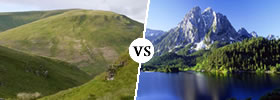

Add new comment